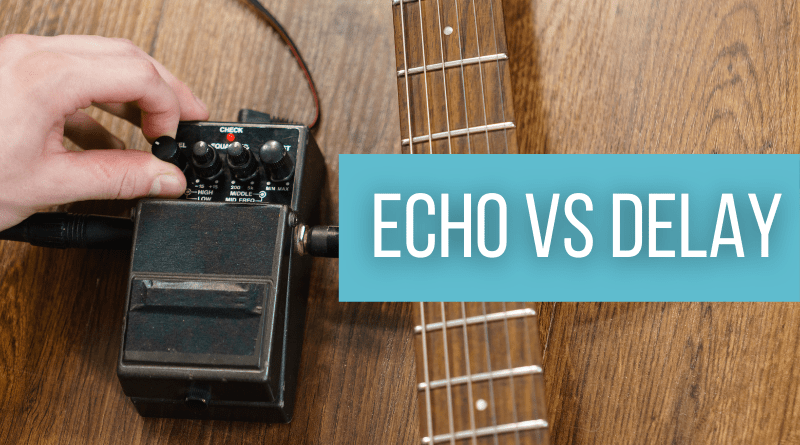One of the most quotable lines from the movie Alien is, “in space, no one can hear you scream.” This is not just a cool quote but in fact, is also factually correct. Why? This is because sound travels in waves and cannot exist in a vacuum.
However, if you decide to scream into a well, you will find that your voice will reflect till it becomes inaudible. This is an example of a delay.
Delays can be of many different kinds. An echo is a type of delay. And here is where the distinction lies:
The main difference between delay and echo is that delays are a wide range of effects, whereas echo is just one type of delay. Delays can include slapback effects to ambient washes, whereas echo is just one type of delay that gives one sound.
That said, whether you use a pedal or add your effects in post-production in a DAW, you may sometimes get confused between a delay and an echo.
So read on, to find out what exactly they are and when to use them.
Contents
What Is An Echo?
An echo is a repetition of sound when soundwaves reflect from a surface. There is a time difference between when the sound is first produced and its return from the reflecting surface. This causes the sound to be heard more than once.
Think of an echo as bouncing a rubber ball on the ground. Here, the ball is a soundwave. It reflects on the ground (surface) and bounces back to you. It will keep bouncing till it loses momentum. Sonically, an echo also dies out after a while.
In audio processing, the delay in when sound is first produced and when its reflection is heard is directly proportional to the distance between the reflective surface and the listener.
A true echo is a single reflection of the source sound and cannot be used for too many things. This is why we use pedals and audio plugins in DAW to emulate multiple echoes.
Notable Uses Of Echo
Elvis Presley’s ‘Baby Let’s Play House’ is one of the earliest examples of an echo in use.‘Blue Ocean Echo’ by Chet Atkins features extensive use of echo on an acoustic guitar. Buckethead’s ‘Big Sur Moon’ is an example of an echo being used heavily to create unique sonic textures.
In the 1970s, the Roland Space Echo RE-201 was instrumental in establishing the dub reggae sound, and producers such as Lee Perry (‘Bird In Hand’) and King Tubby are considered pioneers of this period.
In modern music, subtle uses of an echo include the verses of Incubus’ ‘Wish You Were Here’, ‘Fear Inoculum’ by Tool, and Temper Trap’s ‘Sweet Disposition’.
What Is A Delay?
In audio processing, ‘delay’ is a technique in which an audio signal is recorded and then duplicated and played back via a storage medium such as a tape, a pedal, and even a software plugin.
If you possess or have seen a delay pedal, some common settings on it are for ‘feedback’ which represents the number of delay repeats (the higher the setting, the more repeats), and ‘time’ which determines the length of time between any two repetitions of the audio signal. While there are other controls on a delay pedal, be it analog or digital, these two settings determine the type of delay that is added to one’s sound.
Some of the most common types of delay effects used in music are ping-pong delays, Haas effect, slapback, doubling, multi-tap, echo, looping, etc.
Effects such as chorus, flanging, and reverb are considered delay-based because they use short and modulated delay times.
Notable Uses of Delay
The earliest use of delay can be traced back to the use of tape loops in the 1940s and 50s. This can be heard on the Elvis Presley song ‘Blue Moon On Kentucky’ produced by Sam Phillips.
‘Standing In The Rain’ by The James Gang features a rapidly oscillating Echoplex in the intro whereas The Police’s ‘Walking On The Moon’ has the same delay running throughout the entire song.
David Gilmour used delays extensively in Pink Floyd’s music (‘Shine On You Crazy Diamond’, ‘Time’, ‘Money’, etc). U2’s The Edge is also known for his signature delay-heavy sound. It can be heard in songs such as ‘With Or Without You’, or even on comparatively newer songs such as ‘Vertigo’.
Differences Between Delay And Echo
- Delays are copies of an original signal that are played back within milliseconds of each other. Echoes have a long enough delay time for one to be able to hear a distinct copy of the original sound.
- An echo is a subset, or, type of delay.
- When setting up the signal chain, the delay is usually placed before the echo to create a rich texture. However, in post-production, this can cause the mix to sound muddy.
Shaping Your Sound: When To Use What
In music creation and playback
Use a delay when you want to add texture to your music. You can add a slight delay to make a guitar sound warmer, or even choose a time-delay effect such as a flanger to manipulate your sound. Shoegaze bands such as My Bloody Valentine and the Jesus And Mary Chain incorporate heavy feedback to their sound to create noisy, atmospheric textures.
Use an echo when you want to produce repetitive movements using single notes. This works great on arpeggios. An echo can also be used to add a percussive element to your music. If you want to recreate a tone similar to Eric Johnson’s, placing your echo before an overdrive will help you achieve that. The echo will help emphasize quieter sections but not be overbearing during louder parts. You can listen to his track ‘Cliffs Of Dover’ to understand how.
In Post-Production
A delay can be used to add ambiance to the overall mix. You can use a delay to create a stereo environment by panning different instruments and setting their feedback levels accordingly. Adding delay to vocals gives it more depth and allows the layer to cover more ground on the sonic spectrum. A kick drum sometimes requires delay to give it more presence.
When you want to accentuate a particular note or even vocal part, add an echo to the individual layer. This will make it stand out from the rest of the mix. In many genres of electronic music, an echo is often added to percussive elements to fill up more room. However, adding an echo to the overall song mix can often make it clumsy and muddy.
Final Thoughts
If you plan to add a delay, especially an echo to your live performance rig, then you must remember the most important thing: you have to play on time. Using these effects can often be tricky because they demand precision, even if playing drone and washed out sounds. But this is not a problem that a little practice with a metronome cannot fix.
While tape echoes became commercially available in the 1950s, analog effect units were invented in the 70s and were followed by digital pedals in the 80s. Software plugins were introduced as late as the 2000s.
But the great thing about an echo and a delay is that they are incredibly versatile and form the basis of many genres of music as we know them today. They continue to thrive as more advancements are made in music creation and technology.


